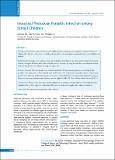Please use this identifier to cite or link to this item:
https://hdl.handle.net/20.500.14356/1941Full metadata record
| DC Field | Value | Language |
|---|---|---|
| dc.contributor.author | Mukhiya, R K | - |
| dc.contributor.author | Rai, S K | - |
| dc.contributor.author | Karki, A B | - |
| dc.contributor.author | Prajapati, A | - |
| dc.date.accessioned | 2023-06-02T05:51:37Z | - |
| dc.date.available | 2023-06-02T05:51:37Z | - |
| dc.date.issued | 2012 | - |
| dc.identifier.citation | MukhiyaR. K., RaiS. K., KarkiA. B., & PrajapatiA. (2013). Intestinal Protozoan Parasitic Infection among School Children. Journal of Nepal Health Research Council. https://doi.org/10.33314/jnhrc.v0i0.333 | en_US |
| dc.identifier.issn | Print ISSN: 1727-5482; Online ISSN: 1999-6217 | - |
| dc.identifier.uri | http://103.69.126.140:8080/handle/20.500.14356/1941 | - |
| dc.description | Original Article | en_US |
| dc.description.abstract | Abstract Background: Intestinal protozoan parasitosis is highly prevalent among general population, majority of them are children. The objective of the study is to find out the prevalence of intestinal protozoan infection in school children of Sindhuli. Methods: Stool samples were collected from school children of Sindhuli in June 2011 and investigated in National Institute of Tropical Medicine and Public Health Research, Laboratory by using formal-ether concentration method. Statistical significance was analyzed by using Chi-Square test. Results :A total of 342 stool samples were collected and 68 (19.8%) protozoan parasites were identified. The prevalence rate of protozoa in boys and girls were 16.9% and 22.0% respectively. Altogether 5 species of protozoan parasites were detected. Of them Entamoeba coli was most common followed by Giardia lamblia, Entamoeba histolytica, Blastocystis hominisand Endolimax nana. Positive rate was highest in Dalit (20.3%), and least in Indo-Aryan (19.6%). Conclusions: There is a low prevalence of intestinal protozoan parasitosis among children even though this study emphasizes the need for improved environmental hygiene i.e. clean water supplies and enhanced sanitation. Keywords: intestinal protozoan parasite; school children. | en_US |
| dc.language.iso | en | en_US |
| dc.publisher | Nepal Health Research Council | en_US |
| dc.relation.ispartofseries | Sep-Dec, 2012;333 | - |
| dc.subject | Intestinal protozoan parasite | en_US |
| dc.subject | School children | en_US |
| dc.title | Intestinal Protozoan Parasitic Infection among School Children | en_US |
| dc.type | Journal Article | en_US |
| local.journal.category | Original Article | - |
| Appears in Collections: | Vol. 10 No. 3 Issue 22 Sep - Dec, 2012 | |
Files in This Item:
| File | Description | Size | Format | |
|---|---|---|---|---|
| 333-Article Text-332-1-10-20130823.pdf | Fulltext Download | 184.12 kB | Adobe PDF |  View/Open |
Items in DSpace are protected by copyright, with all rights reserved, unless otherwise indicated.
